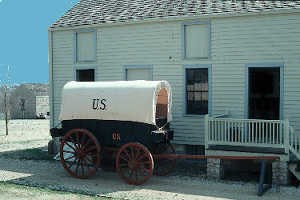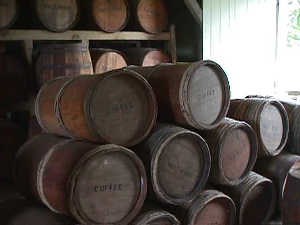
During the 1840s, the Quartermaster Department was responsible for the construction, maintenance, and supply of all the army forts and military roads. The Quartermaster's Storehouse at Fort Scott was constructed from 1842-43. Fort Scott's most important Quartermaster was Captain Thomas Swords-who designed and supervised the construction of the fort. Captain Swords was assisted in the operation of his department by a sergeant, a forage master, and one or two clerks. The storehouse contains six rooms and could be considered as a 19th Century Hardware and Grocery Warehouse. Each company of soldiers was issued a specified amount of public property and each soldier was responsible for his uniform, weapons, and equipment. If a soldier lost, damaged, or destroyed a piece of public property, he was required to pay for a replacement. In fact, the cost of the replacement was deducted from his pay, before he was paid. 
Part of the storehouse served as the Commissary or Military Grocery Warehouse of the 19th Century. The army shipped everything in boxes, crates, sacks, kegs, and barrels to prevent things from being stolen or damaged. The subsistence officer was responsible for ordering, inspecting, and issuing all of the food such as salt pork, salt beef, beans, coffee, flour, rice, salt, and sugar. The army purchased large amounts of food from civilian contractors and the Subsistence Officer had to inspect each shipment to make sure that it was acceptable. The contractors often tried to cheat the army by delivering bad flour, green barrels, and soft candles. The quartermaster storehouse is the only fort building which has a basement where the cool temperature prevented perishable items such as vegetables, molasses, vinegar, whiskey, candles, and soap from spoiling from the heat. Tools, supplies, and subsistence items not available on the frontier were purchased back east by the army and shipped to Jefferson Barracks, Missouri, near St. Louis. From there the supplies were shipped on steamboats up the Missouri River to Fort Leavenworth and then in wagons down the military road to Fort Scott. The storehouse was part of a complex of buildings known as the Quartermaster Quadrangle. This area included corncribs, stables for the mules, horses, and oxen that pulled the supply wagons, a blacksmith shop, and carpenter shops. Only two other quartermaster buildings exist today, a small stone building, which was probably a blacksmith shop, and the bake house. The information for this section came from an anonymous article written by park staff at Fort Scott National Historic Site. |
Last updated: July 29, 2016

